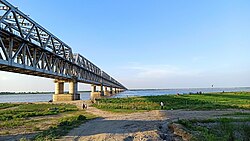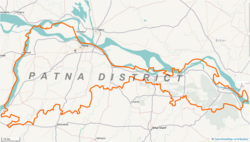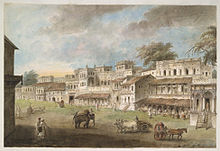| Patna district | |
|---|---|
| District of Bihar | |
     Clockwise from top-left: Golghar, Tomb of Shah Makhdum Daulat Maneri and Ibrahim Khan, Gurudwara Patna Sahib, Digha–Sonpur Bridge, Rajkiya Hospital in Bharatpur Clockwise from top-left: Golghar, Tomb of Shah Makhdum Daulat Maneri and Ibrahim Khan, Gurudwara Patna Sahib, Digha–Sonpur Bridge, Rajkiya Hospital in Bharatpur | |
 | |
 | |
| Coordinates (Patna): 25°25′N 85°10′E / 25.417°N 85.167°E / 25.417; 85.167 | |
| Country | |
| State | |
| Division | Patna |
| Headquarters | Patna |
| Government | |
| • Lok Sabha constituencies | 1. Pataliputra, 2. Patna sahib, 3. Munger (shared with Munger district) |
| • Vidhan Sabha constituencies | 14 |
| Area | |
| • Total | 3,202 km (1,236 sq mi) |
| Population | |
| • Total | 5,838,465 |
| • Rank | (IN: 15th) |
| • Density | 1,800/km (4,700/sq mi) |
| • Urban | 2,514,590 |
| Demographics | |
| • Literacy (2011) | 70.68% |
| • Sex ratio | 1.897 ♂/♀ |
| Time zone | UTC+05:30 (IST) |
| Major highways | NH 30, NH 83 |
| HDI (2016) | |
| Website | patna |
Patna district is one of the thirty-eight districts of Bihar state in eastern India. Patna, the capital of Bihar, is the district headquarters. The Patna district is a part of Patna division. The Patna district is divided into 6 Sub-divisions (Tehsils) i.e. Patna Sadar, Patna City, Barh, Masaurhi, Danapur and Paliganj.
As of 2011, it is the most populous district of Bihar and fifteenth most populous district in India.
The revenue district of Patna comes under the jurisdiction of a District Collector (District Magistrate). The office of the Patna DM is in Patna Collectorate.
History
Patna is one of the oldest continuously inhabited places in the world. Patna was founded in 490 BCE by the king of Magadha. Ancient Patna, known as Pataliputra, was the capital of the Magadha Empire under the Haryanka, Nanda, Mauryan, Shunga, Gupta and Pala empires. Pataliputra was a seat of learning and fine arts. Patliputra was home to many mathematicians, astronomers, astrologists and scholars including Gautam Buddha, Aryabhata, Panini, Vātsyāyana, Chanakya and Kālidāsa. Its population during the Maurya period (around 400 BCE) was about 400,000. Patna served as the seat of power, political and cultural centre of the Indian subcontinent. With the fall of Gupta Empire, Patna lost its glory. It was revived again in the 17th century by the British as a centre of international trade.
Further information: Patna § History

Modern history
The modern district of Patna was created in September 1770 as provincial council by the British, to supervise revenue matters of Bihar. In 1793, Patna became a separate judicial district. This led the foundation of modern district.
The re-organization of the districts in the State took effect in 1972. On November 9, 1972 Nalanda district was constituted by carving out the Bihar Sharif sub-division of Patna district.
Geography
Patna district occupies an area of 3,202 square kilometres (1,236 sq mi), bounded by the Son River to the west, and the Ganges to the north. In the south, it is bordered by the Nalanda, Arwal, by Jehanabad districts, in the east by Begusarai district, and by Lakhisarai to the southeast.
Administration
The Patna district is headed by an IAS officer of the rank of District Magistrate (DM). The district is divided into sub-divisions or Tehsils, each headed by a Sub Divisional Magistrate (SDM).
These Tehsils are further divided into Blocks, each headed by a Block development officer (BDO).
Tehsils
The six sub-divisions or Tehsils in Patna district are as follows:
Blocks
The 23 Blocks under 6 Tehsils in Patna district are as follows:
| Tehsil (Sub-division) | CD Blocks |
|---|---|
| Patna Sadar | Patna Sadar, Sampatchak and Phulwari Sharif |
| Patna City | Fatuha, Daniyawaan and Khusrupur |
| Barh | Athmalgola, Mokama, Belchi, Ghoswari, Pandarak, Bakhtiyarpur and Barh |
| Masaurhi | Masaurhi, Punpun and Dhanarua |
| Danapur | Danapur, Maner, Bihta and Naubatpur |
| Paliganj | Paliganj, Dulhin Bazar and Bikram |
Industries
In Patna district the most Industries are located in Fatuha to DidarGanj.
Demographics
| Year | Pop. | ±% p.a. |
|---|---|---|
| 1901 | 1,028,073 | — |
| 1911 | 1,018,226 | −0.10% |
| 1921 | 998,101 | −0.20% |
| 1931 | 1,168,744 | +1.59% |
| 1941 | 1,357,416 | +1.51% |
| 1951 | 1,600,295 | +1.66% |
| 1961 | 1,861,811 | +1.53% |
| 1971 | 2,250,883 | +1.92% |
| 1981 | 3,019,201 | +2.98% |
| 1991 | 3,618,211 | +1.83% |
| 2001 | 4,718,592 | +2.69% |
| 2011 | 5,838,465 | +2.15% |
| source: | ||
| Religions in Patna district (2011) | ||||
|---|---|---|---|---|
| Religion | Percent | |||
| Hinduism | 91.74% | |||
| Islam | 7.54% | |||
| Other or not stated | 0.72% | |||
According to the 2011 census Patna is the 15th most populous district, with population of 5,838,465, roughly equal to the nation of Nicaragua or the US state of Maryland. The district has a population density of 1,823 inhabitants per square kilometre (4,720/sq mi). Its population growth rate over the decade 2001–2011 was 22.34%. Patna has a sex ratio of 897 females for every 1,000 males, and a literacy rate of 70.68%. 43.07% of the population lives in urban areas. Scheduled Castes and Scheduled Tribes make up 15.77% and 0.15% of the population respectively.
Languages in Patna district (2011)
Magahi (46.35%) Hindi (43.77%) Urdu (5.19%) Bhojpuri (2.67%) Maithili (1.24%) Others (0.78%)At the time of the 2011 Census of India, 46.35% of the population in the district spoke Magahi, 43.77% Hindi, 5.19% Urdu, 2.67% Bhojpuri and 1.24% Maithili as their first language.
Climate
| Climate data for Patna | |||||||||||||
|---|---|---|---|---|---|---|---|---|---|---|---|---|---|
| Month | Jan | Feb | Mar | Apr | May | Jun | Jul | Aug | Sep | Oct | Nov | Dec | Year |
| Mean daily maximum °C (°F) | 23.3 (73.9) |
26.5 (79.7) |
32.6 (90.7) |
37.7 (99.9) |
38.9 (102.0) |
36.7 (98.1) |
33.0 (91.4) |
32.4 (90.3) |
32.3 (90.1) |
31.5 (88.7) |
28.8 (83.8) |
24.7 (76.5) |
31.53 (88.75) |
| Mean daily minimum °C (°F) | 9.2 (48.6) |
11.6 (52.9) |
16.4 (61.5) |
22.3 (72.1) |
25.2 (77.4) |
26.7 (80.1) |
26.2 (79.2) |
26.2 (79.2) |
25.7 (78.3) |
21.8 (71.2) |
14.7 (58.5) |
9.9 (49.8) |
19.65 (67.37) |
| Average precipitation mm (inches) | 19 (0.7) |
11 (0.4) |
11 (0.4) |
8 (0.3) |
33 (1.3) |
134 (5.3) |
306 (12.0) |
274 (10.8) |
227 (8.9) |
94 (3.7) |
9 (0.4) |
4 (0.2) |
1,130 (44.5) |
| Source: worldweather.org | |||||||||||||
Economy
In 2006 the Ministry of Panchayati Raj named Patna one of the country's 250 most backward districts. It is one of the 38 districts in Bihar currently receiving funds from the Backward Regions Grant Fund.
Agricultural products include paddy, maize, pulses, wheat, and oilseeds. Roughly one-third of the area sown is under rice (paddy). Cash crops such as vegetables and watermelons are also grown in the Diara belt. Major industries include leather, handicrafts, and agro-processing.
Politics
Assembly
The district is divided into fourteen assembly constituencies:
- 178 Mokama
- 179 Barh
- 180 Bakhtiarpur
- 181 Digha
- 182 Bankipur
- 183 Kumhrar
- 184 Patna Sahib
- 185 Fatuha
- 186 Danapur
- 187 Maner
- 188 Phulwari (SC)
- 189 Masaurhi (SC)
- 190 Paliganj
- 191 Bikram
Parliamentary
The district has three parliament constituencies:
- 30 Patna Sahib (Lok Sabha constituency), covers Bakhtiarpur, Digha, Bankipur, Kumhrar, Patna Sahib and Fatuha.
- 31 Pataliputra (Lok Sabha constituency), covers Danapur, Maner, Phulwari, Masaurhi, Paliganj, and Bikram.
- 28 Munger/Monghyr (Lok Sabha constituency), covers Barh and Mokama and shared with Munger district.
-Numbers denote constituency number.
Education
Main article: Education in IndiaSchools in Patna are either government run schools or private schools. Schools mainly use Hindi or English as the medium of instruction. Under the 10+2+3/4 plan, after completing their secondary education, students typically enrol in a school with a higher secondary facility affiliated with the Bihar School Examination Board, the Central Board of Secondary Education, the National Institute of Open Schooling, or the Council for the Indian School Certificate Examinations.
List of villages
The Patna district has 1,395 villages and 322 Gram Panchayats under all 23 Blocks. The list of villages in Patna Sadar Block is as follows:
- Alipur ullar
- Digha East
- Digha West
- Fatehpur
- Mahuli
- Mainpura East
- Mainpura North
- Mainpura West
- Marchi
- Nakta Diyara
- Punadih
- Sabalpur
- Sonawapur
See also
Portal:References
- "District wise population in India as of 2011 census". updateOX. 2011-05-24. Archived from the original on 2017-12-29. Retrieved 2017-12-28.
- ^ "District Census Handbook: Patna" (PDF). Census of India. Registrar General and Census Commissioner of India. 2011.
- "District-specific Literates and Literacy Rates, 2001". Registrar General, India, Ministry of Home Affairs. Archived from the original on 14 April 2010. Retrieved 5 October 2010.
- "Development of Human Development Index at District Level for EAG States". March 2016. Retrieved 18 February 2022.
- "Patna Pin Code list, Population density, literacy rate and total Area with census 2011 details". www.indiamapia.com. Archived from the original on 2017-10-17. Retrieved 2017-12-28.
- "Populations of Largest Cities in PMNs from 2000BC to 1988AD". Archived from the original on 29 September 2007.
- "Patna Tour". cultureholidays.com. Archived from the original on 4 April 2016. Retrieved 28 August 2016.
- "Ancient Patliputra". go4patna.com. Archived from the original on 18 October 2016. Retrieved 28 August 2016.
- O'Malley, L. S. S. (2005). James, J. F. W. (ed.). History of Magadha. Delhi: Veena Publication. p. 23. ISBN 978-81-89224-01-1. Retrieved 24 February 2011.
- Singh, Vipul (2005). The Artisans in 18th Century Eastern India, a History of Survival. Concept Publishing Company. ISBN 9788180692352. Archived from the original on 2017-12-29. Retrieved 2017-12-28.
- "Nalanda celebrates foundation day — Times of India". The Times of India. 10 November 2017. Archived from the original on 2017-12-29. Retrieved 2017-12-28.
- Srivastava, Dayawanti; et al., eds. (2010). "States and Union Territories: Bihar: Government". India 2010: A Reference Annual (54th ed.). New Delhi, India: Additional Director General, Publications Division, Ministry of Information and Broadcasting (India), Government of India. pp. 1118–1119. ISBN 978-81-230-1617-7.
- "Table A-02 Decadal Variation in Population Since 1901: Bihar" (PDF). census.gov.in. Registrar General and Census Commissioner of India.
- "Table C-01 Population by Religion: Bihar". censusindia.gov.in. Registrar General and Census Commissioner of India. 2011.
- US Directorate of Intelligence. "Country Comparison:Population". Archived from the original on 27 September 2011. Retrieved 1 October 2011.
Nicaragua 5,666,301 July 2011 est.
- "2010 Resident Population Data". U. S. Census Bureau. Archived from the original on 19 October 2013. Retrieved 30 September 2011.
Maryland 5,773,552
- ^ "Table C-16 Population by Mother Tongue: Bihar". censusindia.gov.in. Registrar General and Census Commissioner of India. 2011.
- "Climatological Information for Patna". World Weather. Archived from the original on 8 August 2013. Retrieved 25 February 2011.
- ^ Ministry of Panchayati Raj (8 September 2009). "A Note on the Backward Regions Grant Fund Programme" (PDF). National Institute of Rural Development. Archived from the original (PDF) on 5 April 2012. Retrieved 27 September 2011.
- By: Manav Saurav : Government of Bihar website :gov.bih.nic.in/Profile/Districts.htm
- "14 segments in Patna dist this time". The Times of India. 5 October 2010. Archived from the original on 2017-12-29.
- "General Election 2009 Assembly constituencies". Pataliputra. India elections.co.in. Archived from the original on 2009-04-24. Retrieved 2017-12-28.
- "Monghyr (Munger) loksabha constituency seat election results". IndiaStudyChannel.com. Archived from the original on 2017-12-29. Retrieved 2017-12-28.
- "Patna Sahib loksabha constituency seat election results". IndiaStudyChannel.com. Archived from the original on 2017-12-29. Retrieved 2017-12-28.
- Dixon, Pauline (2013). International Aid and Private Schools for the Poor: Smiles, Miracles and Markets. Edward Elgar Publishing, 2013. p. 65. ISBN 9781781953457. Archived from the original on 2015-06-19.
- "Class XI admission process begins in many schools". The Times of India. 23 May 2015. Archived from the original on 4 March 2016. Retrieved 29 December 2017.
External links
| Places adjacent to Patna district | ||||||||||||||||
|---|---|---|---|---|---|---|---|---|---|---|---|---|---|---|---|---|
| ||||||||||||||||
| Industries and companies in Bihar | ||
|---|---|---|
| Aurangabad |
|  |
| Bhagalpur | ||
| Buxar | ||
| Muzaffarpur | ||
| Patna |
| |
| Cities and towns in Patna Division | |
|---|---|
| Bhojpur district | |
| Buxar district | |
| Kaimur district | |
| Patna district | |
| Rohtas district | |
| Nalanda district | |
| Patna division topics | |
|---|---|
| General | |
| Districts | |
| Rivers | |
| Dams, barrages | |
| Transport | |
| Railway stations | |
| Lok Sabha constituencies | |
| See also | |